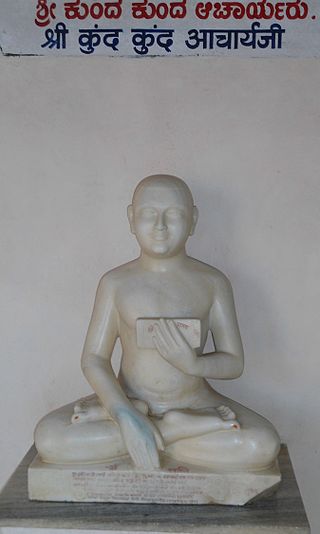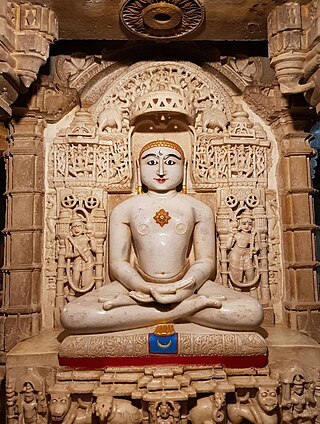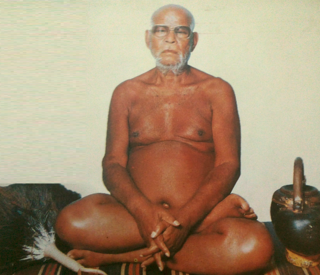Jainism, also known as Jain Dharma, is an Indian religion. Jainism traces its spiritual ideas and history through the succession of twenty-four tirthankaras, with the first in the current time cycle being Rishabhadeva, whom the tradition holds to have lived millions of years ago, the twenty-third tirthankara Parshvanatha, whom historians date to the 9th century BCE, and the twenty-fourth tirthankara Mahavira, around 600 BCE. Jainism is considered an eternal dharma with the tirthankaras guiding every time cycle of the cosmology. The three main pillars of Jainism are ahiṃsā (non-violence), anekāntavāda (non-absolutism), and aparigraha (asceticism).

Mahavira, also known as Vardhamana, was the 24th Tirthankara of Jainism. He was the spiritual successor of the 23rd Tirthankara Parshvanatha. Mahavira was born in the early 6th century BCE into a royal Jain family of ancient India. His mother's name was Trishala and his father's name was Siddhartha. They were lay devotees of Parshvanatha. Mahavira abandoned all worldly possessions at the age of about 30 and left home in pursuit of spiritual awakening, becoming an ascetic. Mahavira practiced intense meditation and severe austerities for twelve and a half years, after which he attained Kevala Jnana (omniscience). He preached for 30 years and attained moksha (liberation) in the 6th century BCE, although the year varies by sect.

The Śvetāmbara is one of the two main branches of Jainism, the other being the Digambara. Śvetāmbara in Sanskrit means "white-clad", and refers to its ascetics' practice of wearing white clothes, which sets it apart from the Digambara or "sky-clad" Jains whose ascetic practitioners go nude. Śvetāmbaras do not believe that ascetics must practice nudity.

Ādi purāṇa is a 9th century Sanskrit poem composed by Jinasena, a Digambara monk. It deals with the life of Rishabhanatha, the first Tirthankara.

Parshvanatha, or Pārśva and Pārasanātha, was the 23rd of 24 Tirthankaras of Jainism. He gained the title of Kalīkālkalpataru.

Ācārya Bhadrabāhu was, according to both the Śvetāmbara and Digambara sects of Jainism, the last Shruta Kevalin in Jainism.
Anekāntavāda is the Jain doctrine about metaphysical truths that emerged in ancient India. It states that the ultimate truth and reality is complex and has multiple aspects.

Acharya Pujyapada or Pūjyapāda was a renowned grammarian and acharya belonging to the Digambara tradition of Jains. It was believed that he was worshiped by demigods on the account of his vast scholarship and deep piety, and thus, he was named Pujyapada. He was said to be the guru of King Durvinita of the Western Ganga dynasty.
Jainism is a religion founded in ancient India. Jains trace their history through twenty-four tirthankara and revere Rishabhanatha as the first tirthankara. The last two tirthankara, the 23rd tirthankara Parshvanatha and the 24th tirthankara Mahavira are considered historical figures. According to Jain texts, the 22nd tirthankara Neminatha lived about 5,000 years ago and was the cousin of Krishna.
Kevala jnana or Kevala gyana, also known as Kaivalya, means omniscience in Jainism and is roughly translated as complete understanding or supreme wisdom.
Mulachara is a Jain text composed by Acharya Vattakera of the Digambara tradition, around 150 CE. Mulachara discusses anagara-dharma – the conduct of a Digambara monk. It consists twelve chapters and 1,243 verses on. It is also called Digambara Acharanga.

Umaswati, also spelled as Umasvati and known as Umaswami, was an Indian scholar, possibly between 2nd-century and 5th-century CE, known for his foundational writings on Jainism. He authored the Jain text Tattvartha Sutra. Umaswati's work was the first Sanskrit language text on Jain philosophy, and is the earliest extant comprehensive Jain philosophy text accepted as authoritative by all four Jain traditions. His text has the same importance in Jainism as Vedanta Sutras and Yogasutras have in Hinduism.

Digambara is one of the two major schools of Jainism, the other being Śvetāmbara (white-clad). The Sanskrit word Digambara means "sky-clad", referring to their traditional monastic practice of neither possessing nor wearing any clothes.

Jainism is an Indian religion which is traditionally believed to be propagated by twenty-four spiritual teachers known as tirthankara. Broadly, Jainism is divided into two major schools of thought, Digambara and Śvetāmbara. These are further divided into different sub-sects and traditions. While there are differences in practices, the core philosophy and main principles of each sect is the same.

Akalanka was a Jain logician whose Sanskrit-language works are seen as landmarks in Indian logic. He lived from 720 to 780 A.D. and belonged to the Digambara sect of Jainism. His work Astasati, a commentary on Aptamimamsa of Acharya Samantabhadra deals mainly with jaina logic. He was a contemporary of Rashtrakuta king Krishna I. He is the author of Tattvārtharājavārtika, a commentary on major Jain text Tattvartha Sutra. He greatly contributed to the development of the philosophy of Anekantavada and is therefore called the "Master of Jain logic".

Chandraprabha or Chandranatha is the eighth Tirthankara of Tīrthaṅkara of Jainism in the present age. According to traditional accounts, he was born to King Mahasena and Queen Lakshmana Devi at Chandrapuri to the Ikshvaku dynasty. According to Jain texts, his birth-date was the twelfth day of the Posh Krishna month of the Indian calendar. He is said to have become a siddha, a liberated soul which has destroyed all of its karma.

Kundalpur is a village in Nalanda district in the Indian state of Bihar. It is located about 2.5 kilometres from ancient Nalanda Mahavihara, 11 kilometres southwest of Bihar Sharif, and 80 kilometres southeast of Patna.

Champat Rai Jain was a Digambara Jain born in Delhi and who studied and practised law in England. He became an influential Jainism scholar and comparative religion writer between 1910s and 1930s who translated and interpreted Digambara texts. In early 1920s, he became religiously active in India and published essays and articles defending Jainism against misrepresentations by colonial era Christian missionaries, contrasting Jainism and Christianity. He founded Akhil Bharatvarsiya Digambara Jain Parisad in 1923 with the aim of activist reforms and uniting the south Indian and north Indian Digambara community. He visited various European countries to give lectures on Jainism. He was conferred with the title Vidya-Varidhi by Bharata Dharma Mahamandal.

Acharya Deshbhushan was a Digambara Jain Acharya of 20th century who composed and translated many Kannada scriptures to Hindi and Sanskrit. He initiated and elevated several Jain monks and nuns like Shwetpichhi Acharya Vidyananda ji and Gyanmati Mataji. He is renowned for his remarkable translations of Kannada scriptures to Sanskrit and Hindi. He is the first Digambara Acharya to visit and address the Indian Parliament in the year 1974 along with the Prime Minister Indira Gandhi.
Bhadrabahu was a Digambara monk from ancient India. He is called Bhadrabahu II or Bhadrabahu the Junior to distinguish him from the earlier Bhadrabahu.













